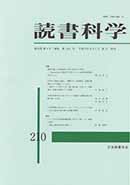Volume 53, Issue 4
Displaying 1-9 of 9 articles from this issue
- |<
- <
- 1
- >
- >|
-
2011 Volume 53 Issue 4 Pages cover1-
Published: 2011
Released on J-STAGE: April 25, 2019
Download PDF (148K) -
2011 Volume 53 Issue 4 Pages TOB1-
Published: 2011
Released on J-STAGE: April 25, 2019
Download PDF (136K)
Original Articles
-
2011 Volume 53 Issue 4 Pages 95-105
Published: August 01, 2011
Released on J-STAGE: April 25, 2019
Download PDF (446K) -
2011 Volume 53 Issue 4 Pages 106-116
Published: August 01, 2011
Released on J-STAGE: April 25, 2019
Download PDF (997K) -
2011 Volume 53 Issue 4 Pages 117-126
Published: August 01, 2011
Released on J-STAGE: April 25, 2019
Download PDF (426K) -
2011 Volume 53 Issue 4 Pages 127-141
Published: August 01, 2011
Released on J-STAGE: April 25, 2019
Download PDF (1586K)
Study Report
-
2011 Volume 53 Issue 4 Pages 142-152
Published: August 01, 2011
Released on J-STAGE: April 25, 2019
Download PDF (434K)
-
2011 Volume 53 Issue 4 Pages Regulation-
Published: 2011
Released on J-STAGE: April 25, 2019
Download PDF (230K) -
2011 Volume 53 Issue 4 Pages Colophon1-
Published: 2011
Released on J-STAGE: April 25, 2019
Download PDF (196K)
- |<
- <
- 1
- >
- >|
